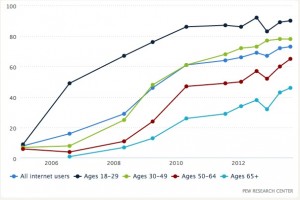 What you see here is the percentage of users of various age groups that use social media from Pew Research Internet Project. For more detailed data on social networking, click here. I have been fortunate to have been a participant of the Internet from very early on. Many of us in Higher Ed would relate to this because we were the first ones to experience it before it was opened up to everyone in early ’90s. In the same fashion, out of my own curiosity, I have been active in social media fairly early on. I am not sure about you, but every morning, when I get up, the first things I check are my social media applications such as Twitter and Facebook before checking my email. I have a careful subselection of everyone I follow on Twitter whose posts I value the most and this provides me such a lot of useful information every morning. While I sleep, they have done the work of scanning the world events and post information that I am most interested. It is like reading a newspaper. Similarly, I get a lot more information on Facebook about friends and family than through emails. The use of social networking tools has been on the rise as you see from the graph. Email, while its use has not declined as much as one would think, serves a whole different purpose. This is where I get most of the professional communications, be it work related or from colleagues from other institutions.
What you see here is the percentage of users of various age groups that use social media from Pew Research Internet Project. For more detailed data on social networking, click here. I have been fortunate to have been a participant of the Internet from very early on. Many of us in Higher Ed would relate to this because we were the first ones to experience it before it was opened up to everyone in early ’90s. In the same fashion, out of my own curiosity, I have been active in social media fairly early on. I am not sure about you, but every morning, when I get up, the first things I check are my social media applications such as Twitter and Facebook before checking my email. I have a careful subselection of everyone I follow on Twitter whose posts I value the most and this provides me such a lot of useful information every morning. While I sleep, they have done the work of scanning the world events and post information that I am most interested. It is like reading a newspaper. Similarly, I get a lot more information on Facebook about friends and family than through emails. The use of social networking tools has been on the rise as you see from the graph. Email, while its use has not declined as much as one would think, serves a whole different purpose. This is where I get most of the professional communications, be it work related or from colleagues from other institutions.
I am a big fan of modular design and reusable “things”. From Wikipedia – “Modular design, or “modularity in design”, is an approach that subdivides a system into smaller parts (modules or skids) that can be independently created and then used in different systems to drive multiple functionalities.” The general idea of looking at a problem and breaking it into smaller and reusable parts doesn’t come naturally to everyone. However, I am a big fan of this methodology and practice this as much as possible. When I was doing my Masters in Chemistry in India, I took a class in Group Theory taught by a fantastic teacher – Prof. P. T. Manoharan. It turns out that Group theory is very handy in understanding symmetries and vibrations in molecules. One of the things we learn there is the concept of “Irreducible Representations”. In simple terms, these are the representations that cannot be broken down further. All other ‘representations’ can be constructed from these. Obviously, this is like modularity somewhat and my fascination for this began in 1977 in my Group Theory class. I believe that this has wired my brain to think the modular way!

